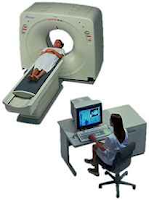BLADDER CANCER
Definition of bladder cancer: Cancer that forms in tissues of the bladder (the organ that stores urine). Most bladder cancers are transitional cell carcinomas (cancer that begins in cells that normally make up the inner lining of the bladder). Other types include squamous cell carcinoma (cancer that begins in thin, flat cells) and adenocarcinoma (cancer that begins in cells that make and release mucus and other fluids). The cells that form squamous cell carcinoma and adenocarcinoma develop in the inner lining of the bladder as a result of chronic irritation and inflammation.
Estimated new cases and deaths from bladder cancer in the United States in 2009:
New cases: 70,980
Deaths: 14,330
Signs and symptoms Bladder cancer
New cases: 70,980
Deaths: 14,330
Signs and symptoms Bladder cancer
Bladder cancer characteristically causes blood in the urine; this may be visible to the naked eye (frank hematuria) or detectable only by microscope (microscopic hematuria). Other possible symptoms include pain during urination, frequent urination (Polyuria) or feeling the need to urinate without results. These signs and symptoms are not specific to bladder cancer, and are also caused by non-cancerous conditions, including prostate infections and cystitis. Kidney cancer also can cause hematuria.
Causes Bladder cancer
Tobacco smoking is the main known cause of urinary bladder cancer: in most populations, smoking causes over half of bladder cancer cases in men and a sizeable proportion in women. There is a linear relationship between smoking and risk, and quitting smoking reduces the risk. In a 10-year study involving almost 48,000 men, researchers found that men who drank 1.5L of water a day had a significantly reduced incidence of bladder cancer when compared with men who drank less than 240mL (around 1 cup) per day. The authors proposed that bladder cancer might partly be caused by the bladder directly contacting carcinogens that are excreted in urine. Thirty percent of bladder tumors probably result from occupational exposure in the workplace to carcinogens such as benzidine. 2-Naphthylamine, which is found in cigarette smoke, has also been shown to increase bladder cancer risk. Occupations at risk are metal industry workers, rubber industry workers, workers in the textile industry, and people who work in printing. Some studies also suggest that auto mechanics have an elevated risk of bladder cancer due to their frequent exposure to hydrocarbons and petroleum-based chemicals. Hairdressers are thought to be at risk as well because of their frequent exposure to permanent hair dyes.
Read more...
Tobacco smoking is the main known cause of urinary bladder cancer: in most populations, smoking causes over half of bladder cancer cases in men and a sizeable proportion in women. There is a linear relationship between smoking and risk, and quitting smoking reduces the risk. In a 10-year study involving almost 48,000 men, researchers found that men who drank 1.5L of water a day had a significantly reduced incidence of bladder cancer when compared with men who drank less than 240mL (around 1 cup) per day. The authors proposed that bladder cancer might partly be caused by the bladder directly contacting carcinogens that are excreted in urine. Thirty percent of bladder tumors probably result from occupational exposure in the workplace to carcinogens such as benzidine. 2-Naphthylamine, which is found in cigarette smoke, has also been shown to increase bladder cancer risk. Occupations at risk are metal industry workers, rubber industry workers, workers in the textile industry, and people who work in printing. Some studies also suggest that auto mechanics have an elevated risk of bladder cancer due to their frequent exposure to hydrocarbons and petroleum-based chemicals. Hairdressers are thought to be at risk as well because of their frequent exposure to permanent hair dyes.









